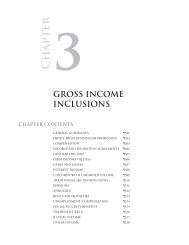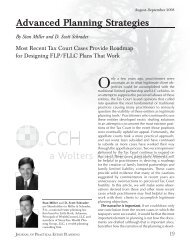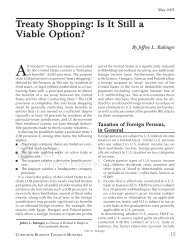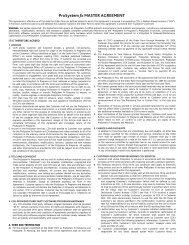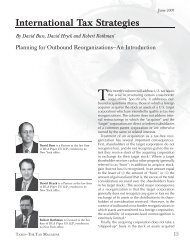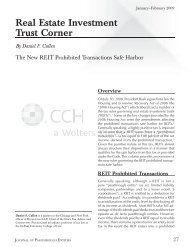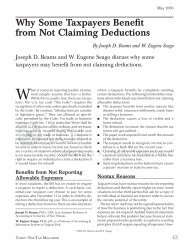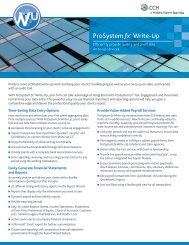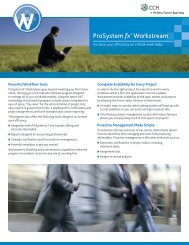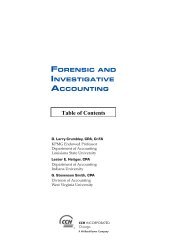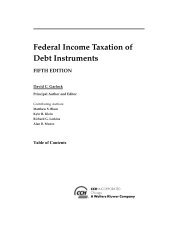The Art of Preparing a Successful Written Protest By William P ... - CCH
The Art of Preparing a Successful Written Protest By William P ... - CCH
The Art of Preparing a Successful Written Protest By William P ... - CCH
You also want an ePaper? Increase the reach of your titles
YUMPU automatically turns print PDFs into web optimized ePapers that Google loves.
April–May 2008Discipline is essential. We must constantly remindourselves to include only those facts that are requiredto answer the question asked (issue raised) by theexamining agent. Nothing more, nothing less!Secondly, we inject irrelevant law into the argument.Too <strong>of</strong>ten we are enamored with the law. Weread an interesting case and become fascinated byit. However interesting, some cases or other legalauthorities have little bearing on the augment beingdeveloped. Including unnecessary legal authorizes inyour argument is a mistake. It serves only to distractthe attention <strong>of</strong> the AO, thus weakening your argument.Again, discipline is essential here.Finally, we fail to make logical connections betweenissues, facts and law. We might be diligent inincluding only those facts and law that are essentialto answering the question posed; however, we don’ttake the next step <strong>of</strong> connecting them. To develop aconvincing argument, we need to connect the facts tothe law in such a way as to create a coherent “whole,”not just a presentation <strong>of</strong> relevant, but unconnectedfragments <strong>of</strong> facts and law. Look for the thread thatties issues, facts and law together. Test the plausibility<strong>of</strong> your argument. Is your response to the questionasked supported by underlying facts, or have youmade assumptions that cause your argument to bevulnerable? Have you adequately applied the law tothe facts, or does your presentation <strong>of</strong> legal authoritiesappear to serve no other purpose other than fillingthe page? Frequently, we spend too much time gatheringlegal authorities, but then fail to “put the lawto work” in developing the argument. Every statute,case, regulation and ruling included in your protestshould work to support your argument. If certaincases or rulings are not “working” to support yourargument, get rid <strong>of</strong> them.<strong>The</strong> traditional method for making connections ina legal argument is through the use <strong>of</strong> analogical reasoning.In general, analogical reasoning is a form <strong>of</strong>reasoning that allows us to connect issues with factsExample 1. Analogical Reasoning *Suppose, for example, that a court faces a case in which the defendant, a contractor, found buriedmoney under the plaintiff’s garage. <strong>The</strong> court surveys past cases having to do with things lost and foundand finds the following:Several cases in which someone found money on the floor <strong>of</strong> a shop or similar premises andthecourts held that the finder was entitled to retain possession as long as the owner <strong>of</strong> the lostproperty pwas notknownSeveral cases in which someone found money on a table in a shop or on a chair in a bank safedeposit room and the courts held that the owner <strong>of</strong> the place where the money was found wasentitled topossessionoA case in which someone found a brooch on a window ledge in a house temporarily requisitionedby the government and the court held that the finder was entitled to possession<strong>The</strong> court might then propose the following analogy—warranting rule: when property is found incircumstances that suggest its owner set it down deliberately and then forgot it, the right to possessionshould go to the owner <strong>of</strong> the place where the property was found. If, however, it seems that the ownerdropped the property inadvertently, possession should go to the finder. This rule leaves one possiblyrecalcitrant case (the case <strong>of</strong> the brooch), but the rule appears to be justified by a broader analogy—warranting rationale—that owners who have set property down and then forgotten it are more likely toreturn to the site than those who have dropped their property inadvertently. <strong>The</strong> more likely the owneris to return, the less appealing it is to award the property to finders who are comparatively more difficultfor the owner <strong>of</strong> the lost property to trace. <strong>The</strong>se ideas in turn can be tested at higher levels <strong>of</strong> generality:a rule designed to return lost property to its owner will make property rights more secure, secureproperty rights contribute to general prosperity, and so forth. <strong>The</strong> analogy-warranting rule can also betested against hypothetical future cases to see if it produces satisfying outcomes. If the results <strong>of</strong> testingare acceptable, and if we assume that the prior decisions were correct, we may now have some reasonto believe that the money found under the garage should stay with the owners <strong>of</strong> the house.*This example is from Emily Sherwin, A Defense <strong>of</strong> Analogical Reasoning in Law, 66 U. CHI. L. REV. 1179 (1999), at 1182–83.JOURNAL OF TAX PRACTICE & PROCEDURE 43





